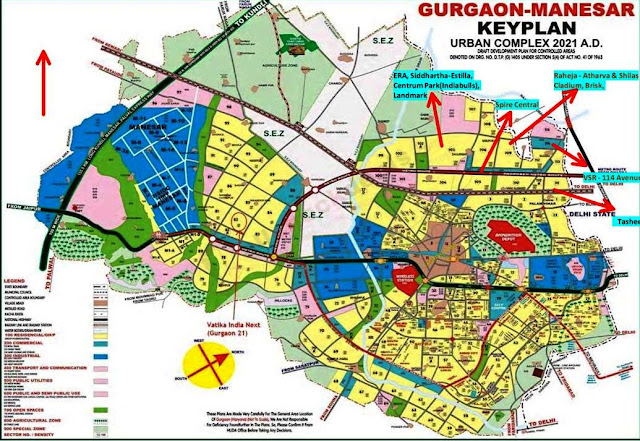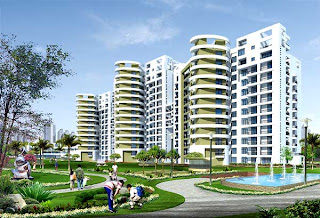Dwarka Expressway - Best Destination for Investments
India is one of the fastest growing major economies of the world with a GDP growth of 6.7% in the fiscal year 2009 and an expected growth of 6.5% in the fiscal year 2010: RBI. The services sector has grown at a rapid pace in recent times.An important factor in the development of the services sector has been the strong growth of the IT and ITeS.Growth of IT and ITeS in the NCR region,especially in Gurgaon, has had positive effect not only in Gurgaon but its adjacent areas and Dwarka.
Dwarka is mushrooming as the hub of commercial and entertainment activities and is amongst the most preferred locations to stay in the NCR region. And with the Gurgaon-Manesar Master Plan 2021,the region will witness further expansion of the Gurgaon city.
Therefore,automatically,a question that is being raised is on the civil infrastructure to support the traffic in and out of city.There are speculations around the viability of the NH 8 and Mehrauli-Gurgaon road in handling the traffic load;and whether the Metro line reduce the number of vehicles plying in and out of Gurgaon. Presently,the NH 8 serves as the aorta distributing the traffic approaching both in and out of the city. However choking of this main circulating system is not uncommon,therefore the need for a parallel highway that links Dwarka and Gurgaon and frees NH 8 from its existing burden of commuters from Delhi.
The Dwarka Expressway or Northern Peripheral Expressway is an eight-lane,expressway being developed by the Haryana Urban Development Authority (HUDA) at a cost of Rs 120 crore.This expressway is a part of Gurgaon-Manesar Master Plan 2021 (Urban Complex Plan) and will connect Dwarka to the NH 8 and will have 30 metres of green belt on both sides.This will be achieved through the addition of green belt areas,an increase in the residential units and commercial spaces,and improvements in connectivity with Delhi.
Compared to 9,881 hectares in the earlier master plan,the new master plan is spread over 33,726 hectares and includes 58 new sectors in addition to the existing 57 sectors.The Gurgaon-Manesar Urban Complex Plan 2021 is unique in a way that it plans to reduce population density in the newly urbanized areas,as compared to existing urbanized districts.
The proposed Dwarka Expressway is an 18km stretch of 150m wide-road starting from Dwarka,which will connect Palam Vihar and the forthcoming big SEZs in Gurgaon to join the NH 8 near Kherki Dhaula.The road from Dwarka is expected to reduce the travel time from west Delhi by half.If one stays in Dwarka,he will no longer have to hit the congested NH 8 before the Delhi-Gurgaon border and the toll bridge.The new link would be parallel to the expressway till it merges ahead of the IFFCO Chowk.The proposed expressway will touch 16 new nearby residential colonies and would also touch a commercial corridor and link with Harsaru dry port. With the land acquisition nearing completion and awaiting hearing from the court on demolition of some houses in Palam Vihar,the project is all set to provide new connectivity between Gurgaon and Dwarka and international and domestic airport resulting in increased real estate activity in the area,from Sector 99 to 115 in Gurgaon.A number of private builders have acquired licences from the Haryana state government to develop townships beside the expressway and to connect it to the proposed Southern Peripheral Expressway.The SEZs by Reliance and Haryana government would also be its major touching points.The upcoming sectors of Gurgaon,particularly residential Sectors 102 and 103,located in proximity to the proposed SEZ area as per the Gurgaon-Manesar Master Plan 2021 will be 'hot property' in the near future.
The real estate sector in the NCR,and especially Gurgaon,has grown in importance with the liberalization of the Indian economy.The consequential increase in business opportunities and migration of people to Gurgaon has in turn,increased the demand for commercial and housing space,especially rental housing. Developments in the real estate sector influence,and are in turn affected by the developments in the retail,hospitality and entertainment industries (like hotels,resorts,cinema theaters),community services (like hospitals,schools) and IT and ITeS (like call centers).Rising demand from the technology sector,demographic shift (increasing disposable incomes and urbanization),suburban developmental models and favorable government policies have changed the face of India's real estate development sector.The growing disposable income of India's middle and upper-income classes,together with changes in lifestyle,has resulted in a substantial change in the nature of consumer demands. Increasingly, consumers are seeking better housing and better amenities like schools,retail areas,health clubs and parks in new residential developments. Lower interest rates on financing from India's retail banks and housing finance companies,particularly for residential real estate,and favorable tax treatment of loans,have helped fuel the recent growth of the Indian real estate market.
The advantages of these sectors are immense if we were to compare to other sectors in Gurgaon,all the infrastructural issues like bad connectivity,shortage of power,lack of green areas and parks,low water levels,etc,are not present in this area.In fact,the lessons learnt from Gurgaon have woken up the government to go about this development in a very planned manner.Embassies are moving to this new location,owing to its excellent connectivity and proximity to the international airport too.
Therefore,investment into real estate in these sectors is very lucrative and perhaps will give back returns manifold in comparison to any other sector in Gurgaon.



Nice post.. I was looking for something same, with all updated information...
ReplyDelete